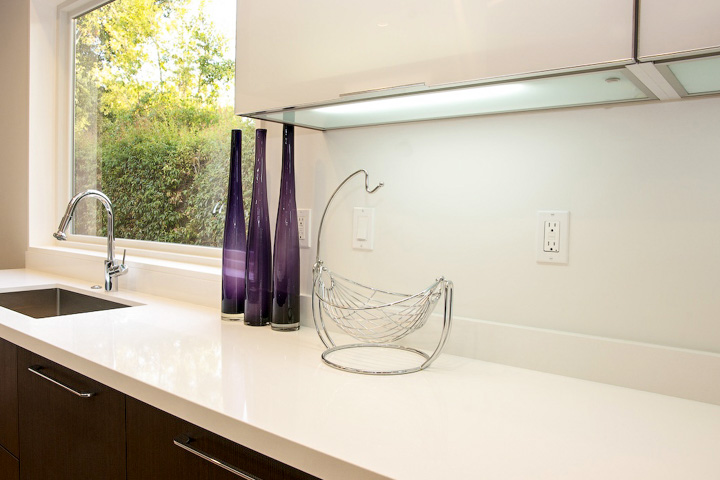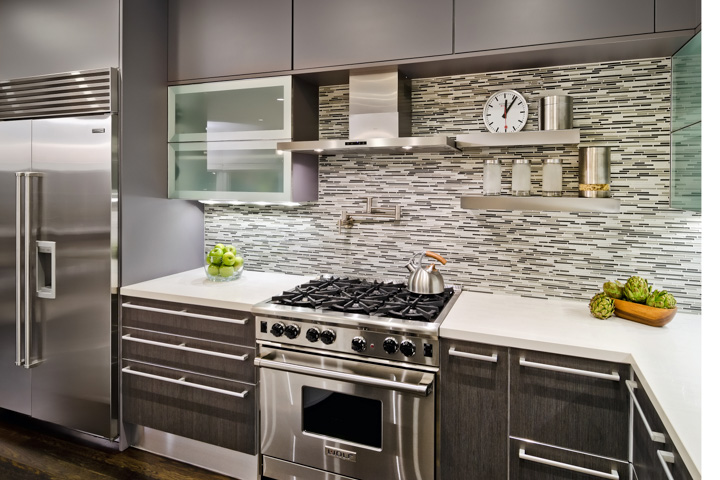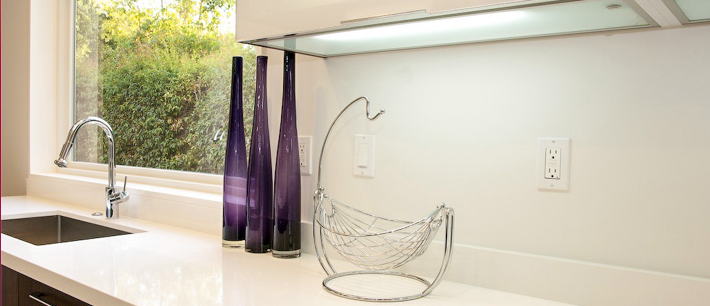5 reasons you want to have under cabinet lighting, plus how to navigate the myriad of options available.
Good lighting can make the difference between a kitchen that is pleasant and inviting, a place where you’ll enjoy preparing meals and gathering with friends and family, or a kitchen that is either too dark or has too many shadows, which makes it difficult to see the food you’re preparing or too bright, like a hospital waiting room.
When designing your new kitchen, you need to think not only about the cabinet configuration, appliances, flooring, and wall color; you also need to consider your lighting plan.
A combination of overhead (ceiling mounted or recessed lights) and pendant lighting is an obvious choice. But the benefits of under cabinet lighting are not to be (excuse the pun) taken lightly.
There is a myriad of options available—built-in, aftermarket, strip, puck, LED, fluorescent, battery-powered, or hardwired. To save you a little time and a huge headache, we’ve put together this complete guide to under cabinet lighting, including why you should have it, and what to know before you get it.
THE BENEFITS OF UNDER CABINET LIGHTING
Before we start with the benefits, let’s get the terminology correct: We’re talking about under cabinet lighting, which is lighting mounted on the underside of the upper wall cabinets. This is often called under counter lighting, however, that’s an incorrect term. You can also have under counter lighting, which would mean you mount a small strip of lights on the underside of the countertop. This type of lighting is purely decorative.

Now, on to the benefits…
1. First and foremost, under cabinet lighting increases the quality of light in your kitchen by providing light specifically where you’re working—on the countertop. If you’re working under overhead lighting alone, you’ll likely have a lot of shadows precisely where you’re holding that sharp knife.
2. Lighting up the countertop directly makes for a much more pleasant work environment.
3. Whether you’re installing under cabinet lighting during a kitchen renovation or after the fact, the process is extremely easy to do.
4. Adding under cabinet lighting to your kitchen will ultimately save you money on your energy bill because you’ll be able to light up the workspace without turning on the lights in the whole room. These savings increase if you choose LED lights and put different sections of lighting on different switches.
5. A beautifully lit kitchen will increase the value of your home. On average, you can expect to recoup approximately 60% of the cost of a major kitchen remodeling project on resale, but the hotter the market, the greater the payback. Adding small, relatively inexpensive details like well designed under cabinet lighting is a great way to increase your ROI.

TYPES OF UNDER CABINET LIGHTS
There are three primary types of under cabinet lights. Linear lights are basically what they sound like: a long strip of tiny bulbs attached to a slim casing or one single long bulb. The casing may be a tape, a rope, or a hard plastic or metal strip. Rope lights are good for longer sections while tape lights are good for unusually shaped sections.
Puck lights are slim, hockey-puck-sized disks. Puck lights are often battery powered and attached to the cabinets with a sticky film. This type of light is good for small spaces or areas without access to a plug.
The third type of under cabinet lighting is integrated lighting. Various after-market manufacturers lighting that can be built-in to your cabinets. Some cabinet manufacturers also supply integrated lighting systems designed specifically for their cabinets. This is the most seamless option but requires that the lights be integrated into the kitchen cabinets during the design phase.

POWER & VOLTAGE
There are three ways to power under cabinet lighting: hardwire, plug-in, or battery. Hardwire means that the lights are connected directly to a switch on the wall. You could have one switch for all of your under cabinet lights, or group them so that you can turn on different areas independently.
Plug-in lights are simply strips of lights that plug into an existing socket. Some older kitchens have been built with sockets hidden on the underside of the upper cabinets specifically for this purpose. While you could have a wall switch that turns on and off a set of sockets, likely you’ll have to turn each bank of lights on and off individually.
Battery-powered pucks or strips are a great option in an older kitchen or to brighten up a rental. A general disadvantage of battery-powered lights, whether strips or pucks, is that you have to replace the batteries occasionally—the batteries will likely have a shorter light span than the light bulb. You’ll also have to turn each unit on and off individually. However, some manufacturers now offer sets of lights that can be controlled by a single remote control.
Under cabinet lights are available as “line voltage” or “low voltage”. Line voltage means they run on the same voltage as the rest of your home. You simply plug them in and turn them on. Low voltage means that you’ll need a transformer to convert your home’s voltage supply to a much lower voltage. However low-voltage lights are generally smaller, last longer, and use less energy.

BULBS
LED lighting is the most popular choice in a modern kitchen. Most importantly, LEDs burn cool, which is important for lights that will be attached to the underside of cabinets where food will be stored. Because LED strip lights are generally not as bright as fluorescent or xenon bulbs or a larger bank of integrated LEDs, you may want to consider using two strips side by side.
While LEDs are more expensive than other types of bulbs, they last several times longer and use a fraction of the energy making them much more cost-effective than their price tag may at first suggest. LEDs are also the best choice if sustainability is important to you.
The fluorescent bulbs of today are not the same bulky, buzzing, flickering lights you may remember from your childhood kitchen. Modern fluorescent bulbs, while still generally available as a long tube, are thinner, longer lasting, and create a better quality of light. However, while they are less expensive than other types of lighting, they still require more power and don’t last as long as LEDs, so they’re not as cost-effective in the long run and they’re also not as environmentally friendly.
A Xenon bulb is similar to an incandescent bulb, but inside the bulb, there’s a gas rather than a vacuum—the bulbs get their name from the xenon gas inside. This bulb emits a warm light similar to an incandescent light and can be dimmed. Xenon bulbs burn cooler than incandescent or halogen bulbs, but they’re not as efficient as fluorescent and LED lights.
It’s possible to find some inexpensive under cabinet lights with halogen or incandescent bulbs, but these should be avoided: Both halogen and incandescent bulb burn very hot and they have a relatively short lifespan, not to mention how environmentally unfriendly they are.

COLOR TEMPERATURE & BRIGHTNESS
When considering the type and style of under cabinet lighting, you’ll also want to consider the color temperature of the bulb. Different types are available in a different variety of color temperatures. Too cool, and the effect is sterile; too warm, and the room appears yellow. LED lights generally give off a temperature that is on the cooler end of the spectrum, but they can be placed behind a shaded lens, which will affect the temperature (and if you want, the hue) of the light they give off.
The color temperature you choose should be determined in part by your style, and in part by the other colors in your kitchen. If your kitchen is designed predominantly with warm colors—reds, oranges, yellows—you should choose warmer lighting. If your kitchen is designed with cooler colors—grays, blues, greens, or white—you’ll want cooler lighting.
It should also be noted that color temperature and brightness is not the same thing. You can have very bright, very warm lights, or very cool, very dim lights, or vice versa. Brightness will depend in part on how much lighting you install, and also the lumen value of the bulb. In a darker kitchen, you’ll want brighter lights, while in a kitchen with a bright white countertop, the lighting won’t need to be as bright because the countertop will reflect light making the room appear brighter.
Lastly, countertops with a matte finish reflect light more smoothly, while shiny countertops like high-polished granite will create more glare. This should be taken into consideration when choosing the brightness of your under cabinet lighting. If your countertop is made of a highly reflective or bright material, it’s especially recommended to choose some type of integrated lighting where the bulbs are behind a frosted lens. The result will be a quality of light that is much more pleasant for working in the kitchen.

MOUNTING & INSTALLATION
Integrated lighting is generally concealed behind a piece of frosted glass or polycarbonate, which provides a wide swath of even lighting across the countertop. Strip lighting or puck lights should be mounted to the underside of the upper wall cabinets toward the front. Because the wall cabinets are generally half the depth of the countertop, mounting the lights in the middle, or worse, at the back of the wall cabinets will reduce the lit area below.
Depending on their diameter, puck lights should be installed approximately 8 – 12 inches apart. Mounting them too far apart will create areas of light and dark, which is as uncomfortable to work under, as it is to look at.
No matter the type of light you choose, under cabinet lighting is easiest to install when the kitchen is first being built, especially if you choose a hardwired built-in option. In a modern kitchen, recessed or otherwise integrated lighting is the best choice for a clean, sleek look.
If you’re installing under cabinet lights to an existing kitchen, you’ll likely be limited to some type of battery-powered or plug-in fixture. Traditional and transitional kitchen cabinets are usually designed with approximately two inches of decorative molding at the base, which is convenient for hiding after-market lighting fixtures, but modern kitchen cabinets don’t have this extra molding. Lighting can still be added later in the form of LED strips, which are so thin you’d have to really look for them to see they’re there.
OTHER PLACES TO USE UNDER CABINET LIGHTING
The kitchen isn’t the only place you might want to add under cabinet lighting. You can also find it in the bathroom, the laundry room, or even the living room or study to light up bookshelves or entertainment centers.
